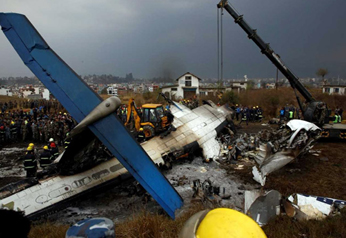DHAKA, April 12, 2018 (BSS) – Nepalese authorities today released the preliminary report on its investigations into the last month’s US-Bangla plane crash in Kathmandu attributing “confusing conversation” between the pilot and the airport control tower to the deadly accident.
“As per the voice record of ATC (Air Traffic Control), we found no appropriate communication between the pilot and the control tower for only 47 seconds before the crash,” Bangladesh representative to the Nepalese investigation commission Captain Salahuddin M Rahmatullah told a media briefing.
Talking to the newsmen at the Civil Aviation Authority (CAAB) headquarters here this afternoon he said the two way communication between the pilot and ATC was not made properly for the last 47 seconds ahead of the crash.
A US-Bangla aircraft crashed at the Tribhuvan International Airport (TIA) in Kathmandu, Nepal on March 12 killing 51 passengers, including 27 Bangladeshi nationals of the 71 on board.
Captain Salahuddin said the crashed aircraft obtained the airworthiness certificate from CAAB. Moreover, investigation commission didn’t find any technical glitch of the aircraft so far.
“There was no problem in the aircraft, weather was good, the navigation system of TIA was fine, radio transmission between the aircraft and ATC was fine, the only inappropriate thing that we found was the 47-second of interrupted two-way communication between the pilot and ATC,” Captain Salauddin said.
“What went wrong ?… we can only say after decoding of the CVR (cockpit voice recorder) ,” he said adding that all important equipment including the “Black Box” of the crashed aircraft was sent to Transport Safety Board (TSB) of Canada for downloading, decoding, readout and analysis including animation to make the final report.
“We got decoding slot from April 23 to May 4,” he added.
After the accident, the Nepal authority formed a probe body named “Aircraft Accident Investigation Commission, 2018” to investigate the tragic incident. The commission published the report on April 9 as the ICAO’s regulations mentions completing the preliminary report within one month of the accident.
“The aircraft touched down at about 1700 meters down the threshold and on the left portion of centerline of Runway 20 and travelled on ground towards Southeast, went out of the Runway, ran through the inner perimeter fence of the airport area, moved down along rough downslope and finally stopped at about 442 meters Southeast side of the Runway from its initial touch down point,” the primary report said adding “At this point, the aircraft caught fire and was completely destroyed.”
Capt Salahuddin said the commission also found that the alignment of the aircraft was not appropriate when it was approaching at TIA.
The report also mentioned that firefighting and emergency services reached the crash site within two minutes and immediately started operation to douse the flames. Four large foam tenders, one medium foam tender and two water tankers were used with full effectiveness.
It said, the process of investigation is ongoing and the Commission shall make the final report publicly available as per the provisions outlined in Chapter 6, Section 6.5 of ICAO Annex 13.
The reviewing of the available documents and testing, decoding, research and analysis of all pertinent equipment retrieved from the aircraft are ongoing and the results shall be included in final report, it added.
Apart from Nepalese officials, the investigation commission included representatives from the host country, aircraft manufacturer – Bombardier of Canada, and engine manufacturer of the aircraft, a British company.



